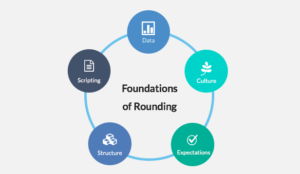As most organizations across the country have taken on Quint Studer’s recommendation to round on their patients, the question begs, “What is the secret sauce to successful organizational rounding?”
If you have rounded on your patients and have not seen improvements in outcomes (for example, CAHPS scores), it might be time to review the five pillars of the rounding process.
CipherHealth discussed the importance of these five pillars in a recent webinar higlighting rounding best practices.
The five pillars of rounding:
Culture –
- Rounding cannot be an add-on activity or the flavor of the month. It needs to be part of the “fabric of the organization”, according to Garza. Rounding needs to transition from a “task to do…to joy to experience”, she said. How can this bring joy to the person doing the rounds?
When done in the right way, rounding provides the chance to connect the organization’s mission to the daily work of caring for the patient. It also gives senior leaders the opportunity to have direct touchpoints with the organization’s mission and the patients impacted by it.
Expectations –
- As part of implementation, CipherHeallth conducts a readiness assessment that assesses the organization’s current state of readiness to implement digital rounding. If the senior leaders are not on-board, for example, then the project may not be successful and should be revisited at a later time.
Garza also indicated that when implementing a new rounding program, leaders should set specific goals for rounding, highlighting the frequency of the rounds and number of opportunities identified.
Structure –
- Rounding is best done if there is a dedicated rounding time. Starting small with just 15 minutes a day can help set the tone for an entire organization. Brunson repeated that it is important to start small and then build on the organization’s successes. You might end up with asking people to round each Friday at 11:00 am, and if so, it is important not to have meetings during that time that might pull people away from rounding. The dedicated rounding time contributes to four success factors: consistency, efficiency, visibility, and accountability.
Another structural component for success is a defined follow-up process. At CipherHealth, we provide alerts and escalations that are routed to different departments for action and resolution. The nurse manager can easily alert another department of an issue and then know it has been resolved in a timely way–great loop closure! Closing the loop is one success element that contributes both to accountability and efficiency.
Scripting – Asking the right questions is a key aspect of any rounding programs. CipherHealth has a wealth of best-practice questions that can identify the right question to ask in order to achieve your desired goals. If you want to compare entities within one organization, it will be important to consider asking the same questions and then report on them. Additionally, it is important that you ask questions that uncover issues that you and the organization can take action upon to drive improvements.
Data – A powerful analytics platform can give your organization meaningful information to “report, reflect and react”, according to Garza. By collecting and analyzing rounding data, your organization can uncover clear ways to drive meaningful improvements in care quality, patient satisfaction, workflows, and more. Without data, rounding can become just another task required by staff instead of a powerful tool used to drive actionable insights.
Would you like to discuss your rounding program with an expert? Our team provides expertise in successfully using a digital rounding tool to achieve your organization’s long-term success. Contact us today and learn how you can enhance rounding programs to achieve organizational goals.








